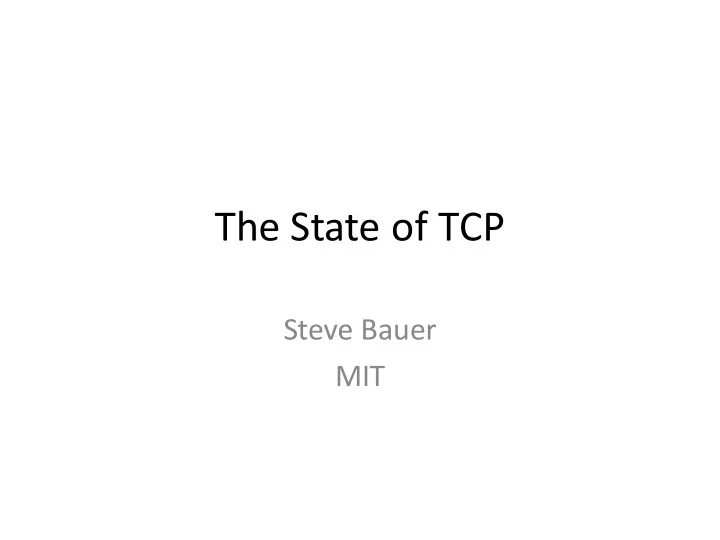

The State of TCP Steve Bauer MIT
RFC 4898: TCP Extended Statistics
1. Inform regulatory processes 2. Suggests research directions 3. Suggests possible changes to IETF standards 4. Improve networking stacks
NDT Glasnost Samknows Bismark Tests Tests Tests Tests Server side Web100 TCP state variables Measurement Lab Infrastructure and Tests
• Over half a billion TCP connections to Mlab • ~ 175 million unique client IP addresses - Jan 1 st 2011 to August 5 th 2011
NDT Samknows Tests Tests Server side Web100 TCP state variables
NDT Samknows Download Download Speed Speed Test Test • Single TCP connection • Three TCP connections • 10 second duration • 30 second duration • Web100 snapshot every 5 • Data logged ever 5 msecs seconds • Packet trace • In the following analysis we used result from 10 second into test since that is most comparable with NDT.
NDT Samknows Download Download March 2011 Speed Speed Test Test • 4.7 million tests • 1.8 million tests • 2.5 million unique IPs • 7300 units 175 IP addresses ran both tests • 293 tests • 33,500 tests
Comparison of measured speeds (March 2011)
Comparison of measured speeds (March 2011)
Comparison of measured speeds (March 2011)
Why do these NDT tests measure slower speeds? • Lots of potential reasons… • 34% of tests don’t fill the pipe enough to generate any congestion signal
Receive window Speed = Round trip time
Measurement Lab NDT data Receive window Speed = Round trip time
Measurement Lab NDT data
What is the bottleneck for a TCP download on your phone? NDT Mobile Client – WiFi? – Cellular?
TCP receiver window limitations are not just a legacy system problem • “Low” memory systems • Take away messages: – TCP tuning is important for valid test measurements – Devices and OSes will eventually will be fixed. This will result in higher but potentially more variable performance.
TCP Slow Start
Latency of transfers ending during slow start = Transfer size Capacity 1.5 or 2 depending on whether delayed ACKs are enabled
TCP Slow Start ACK every packet Delayed ACKs
Description of data • March 2011 NDT Tests – 4.7 million tests – 2.5 million unique IPs • Look at 3.1 million (67%) that experienced congestion • TCP state in first web100 log line where Congestion Signals > 0
CDF of all connections
CDF of single selected provider -50,000 connections - Normal MSS sizes
Factors which reduce ACK stream 1. Delayed ACKs 2. Large receive offload 3. ACK suppression
TCP ACK Suppression • TCP-aware link-layer technique that reduces the number of ACKs sent on the upstream link. • When an ACK from the receiver is about to be enqueued at a upstream bottleneck link interface, the router checks the transmit queues for older ACKs belonging to the same TCP connection. If ACKs are found, some (or all of them) are removed from the queue, reducing the number of ACKs.
ACK Congestion • RFC 3449 TCP Performance Implications of Network Path Asymmetry • Normalized bandwidth ratio (k) is the ratio of the raw bandwidths divided by the ratio of the packet sizes used in the two directions – if the receiver acknowledges more frequently than one ACK every k data packets, the reverse bottleneck link will get saturated before the forward bottleneck link does, limiting the throughput in the forward direction.
Mitigating server side factor • RFC 3465: TCP Congestion Control with Appropriate Byte Counting (ABC) – Limits byte counting to two x maximum segment size – Not generally turned on by default – Some large companies do enable it – Some large companies have patched TCP ABC to remove two x maximum segment size limit
Conclusions 1. Inform regulatory • Samknows/NDT processes comparison 2. Suggests research • ACK suppression directions • Rwin limitations are not a 3. Suggests possible changes legacy system only to IETF standards problem 4. Improve networking • Update RFC 3465 to stacks remove two x maximum segment size limit • Lots more in the works…
Recommend
More recommend